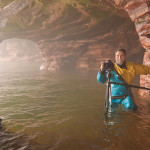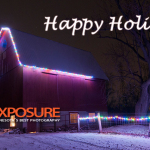Understanding and using stacked focus. Digital Lab 1
Problems we wish to solve all involve close-far distances that exceed the DOF possible with a single capture.
We will be doing multiple captures at different focus points, then blending those together using Helicon Focus software to create an output image containing the sharpest pixels from each image in the stack of captures.
To do the captures, it is essential that the camera be on a sturdy tripod, mirror lock-up, and a self timer or remote shutter release used to eliminate vibrations, and that the subject not move between or during captures.
The f-stop used will always be the one that gives the optimal sharpness and DOF for a given magnification. In most cases, this will be around f/16 for close-ups and f/22 for landscapes with a full size sensor. More open apertures are needed with smaller sensor cameras to avoid loss of sharpness due to diffraction.
As always, it is best to do the capture in RAW. In order for Helicon Focus to see the changes you make in ACR or Lightroom, you need to save the images out as PSDs or TIFFS. I do this to a temporary folder, as I’ll delete these once the image is composited.
So, the workflow is as follows:
• Capture stack of images at different focus points in RAW.
• Process all images identically in ACR or Lightroom.
• Save images to temporary folder as PSD, TIFF files
• Process stack in Helicon Focus
Overall extended DOF in landscape
Most of us are familiar with using hyperfocal distance. The distance you focus at with a given f-stop to get the most DOF out of a lens. The background DOF extends to infinity, and the near limit is ½ the hyperfocal distance.
But, what if you want infinity in focus, AND something closer than the near limit of the hyperfocal distance DOF?
Normally using stacked focus,we work from closest focus to farthest, but in this case, it is easier to work from farther to closer. Just keep in mind that the image will be cropped a bit from your first composition when it is finished.
First of all, set your lens to the hyperfocal distance for the f-stop you will be using and make your first capture.
You will now change the focus to a point to where the far DOF limit slightly overlaps the previous near DOF limit, or one DOF zone. As an example, let’s say in the first capture your DOF extended from 2 feet to infinity. You now must focus so the far limit of DOF is just beyond 2 feet and make your second capture. You continue to shift your focus towards you one DOF zone at a time, making additional captures, until the near limit of the DOF encompasses the closest element in your composition.
You can be very exacting in this by using DOF charts, planning out every capture, or you can simply eyeball it. There is no harm at all in making more captures with a lot of overlap. Personally, I find it easiest to eyeball it, and just error on the side of doing more captures, than to take the time to use a DOF chart.
If you for any reason repeat the process, I strongly suggest making a capture of your hand between sets. This helps differentiate sets when you are processing images.
Overall extended DOF in moderate close up
I do a lot of medium close-up work. Most often of flowers or mushrooms on the forest floor. I usually work from about a 45 degree angle. F/32 often gives enough DOF, but using f/32 degrades the image due to diffraction. So, I find my images are much better using the stacked focus technique, making two or three captures at around f/18. As will most stacked focus images, I will start with the focus on the near focus end, when composing, as this will be my final cropped composition. I then work toward the back one DOF zone at a time.
Overall extended DOF in extreme close up
Because DOF is inversely proportional to the magnification of an image, extreme close-ups were always a challenge with a single capture. Now, we can do what was previously impossible. Things to keep in mind are:
• You should not close down beyond about f/14 (depending upon format and magnification) or you will suffer greatly from diffraction.
• Try not to have very close elements directly against very far elements, because the near ones will be very soft when photographing the background ones, and create a halo around them, blocking the camera from seeing the background around them.
• Remember that your DOF of each capture might be a fraction of a mm. You may need 20 or 30 captures at very small focus changes to capture the entire depth of the subject without skipping over areas.
Overall extended DOF in moderate close up panoramic image
As a printer, I love working with super sharp, very high-resolution files. Prior to stacked focus, doing close-up panoramics often resulted in a compromise in DOF. Now, we can have the best of both worlds — both the sharpness of a stacked focus image, and the high resolution of a panoramic.
• First of all, plan out your panoramic. Usually, this will mean the camera in the vertical position for a horizontal pano.
• Select a longer focal length lens, which will give you a more distant perspective.
• Use a pano head to get the front nodal point over the pivot point of your tripod.
• Get the camera lined up on the left panel of your pano. Starting at the front, make your stack of images.
• Using the pano head, rotate the camera to the right, leaving about a 1/3 overlap with the previous image.
• Return the focus to the front, and make another stack of images.
• Repeat this process to the right, until the entire pano is captured.
• Open all images in ACR or Lightroom and process simultaneously and save as TIFFS or PSDs.
• Process each stack using Helicon Focus and save outputs.
• Process Helicon Output images using Photoshop’s Photomerge.
Extended DOF/selective DOF combination
Extended DOF/selective DOF combination
Sometimes we wish to have really sharp subjects set off against really soft background. This is known as selective DOF or selective focus. While it is possible to achieve this with medium f-stops like f/8, There are two three main reasons this is not the best solution.
First of all, f/8 or wider open apertures do not overcome the aberrations of most lenses, and thus, even the part you focused on will be somewhat soft.
Secondly, it is often difficult to find an f-stop that produces adequate DOF on the subject, while rendering the background sufficiently soft.
The solution is to divide the composition into two elements — the subject and the background.
•When photographing the subject, we will select the f-stop that gives the best sharpness and DOF (likely around f/16). If needed, we will make a stack of images at this f-stop, and process them in Helicon Focus.
• For the background capture, I often move the subject out of the frame, as it will only complicate things later. Whether it is removed or not, you will now make a capture of the background at whatever aperture you prefer for it, not having to worry about the subject.







